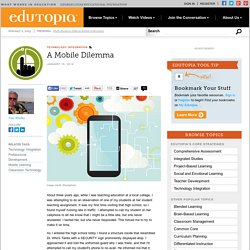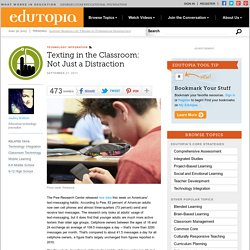

Mobile Learning: 6 Apps and Web Tools for High School Students. With so many high school students owning mobile devices, educators may be missing opportunities by simply banning them.

Experts say schools should take advantage of these tools to engage students and make learning more collaborative. Here are some apps for high school students -- from Edutopia's latest guide, Mobile Devices for Learning: What You Need to Know -- that you can try in your classroom. Share your favorites mobile ideas in the comments below.
Evernote Students can keep notes and gather sources for their projects, all of which can be shared with their teachers and classmates. Twitter Twitter is an information network that’s available online and in app form. The Chemical Touch The periodic table comes alive with an app that provides detailed info on the elements, standard amino acids, and nucleobases. Shakespeare Pro The complete works of the Bard, including 41 plays, are available with a few swipes and clicks of this iPad- and iPhone-enabled app. Socrative SAT Prep Apps. Mobile Learning: 6 Apps and Web Tools for Middle School Students. Building vocabulary with a smartphone game?

Frog dissection in science class without the mess? These are just a few ways mobile devices are changing how students grasp subjects. With that in mind, here are six apps for middle school students from Edutopia's latest guide, Mobile Devices for Learning: What You Need to Know. textPlus This application takes the genius and immediacy of texting and combines it with the power of social networking, allowing for instant out-of-classroom communication. Dropbox No more misplacing papers or presentations. Word Joust Students can go on knightly quests, do battle with trolls, and learn vocabulary words to win points. BrainPOP As far as Web and app resources go, this one could be considered an old-timer, having been around since 1999.
Poll Everywhere An audience-response system app built on text messaging that lets you poll students (think formative assessment) and share their responses immediately. Mobile Learning: 5 Apps and Web Tools for Elementary School Students. Even with the the youngest students, mobile learning can be a powerful tool to build interest.

Apps that gamify math or let students embrace their creativity aren't just fun, they also encourage students to think about their learning in different ways. Here are five to try from Edutopia's latest guide, Mobile Devices for Learning: What You Need to Know. Puppet Pals HD Instead of sitting back and watching TV, why not have children create their own education show? Puppet Pals, an app for tablets, lets students tell their stories with pictures, cartoons, audio, and videos.
I-Nigma Quick Response (QR) and Data Matrix codes, the barcode-like square boxes, are cropping up everywhere in print these days, from newspapers to magazines and books. Nearpod Want to create a multimedia presentation that all of your students can follow at the same pace on an iPad? Martha Speaks Dog Party An app created by PBS KIDS designed to help kids expand their vocabulary. Motion Math Another app with a lot of buzz.
A Mobile Dilemma. About three years ago, while I was teaching education at a local college, I was attempting to do an observation of one of my students at her student teaching assignment.

It was my first time visiting that high school, so I found myself running late in traffic. I attempted to call my student on her cellphone to let her know that I might be a little late, but she never answered. I texted her, but she never responded. This forced me to try to make it on time. As I entered the high school lobby I found a structure inside that resembled Dr. I believe that was also the year that a New Jersey middle school principal grabbed national attention as he not only banned all cellphones in his school, but also urged all parents to deny their children access to social media, because he felt it was unnecessary. A Critical 21st Century Skill Now here we are in the year 2014, and things seem to be changing for many schools.
Texting in the Classroom: Not Just a Distraction. The Pew Research Center released new data this week on Americans' text-messaging habits.

According to Pew, 83 percent of American adults now own cell phones and almost three-quarters (73 percent) send and receive text messages. The research only looks at adults' usage of text-messaging, but it does find that younger adults are much more active texters than older age groups. Cellphone owners between the ages of 18 and 24 exchange an average of 109.5 messages a day -- that's more than 3200 messages per month.
That's compared to about 41.5 messages a day for all cellphone owners, a figure that's largely unchanged from figures reported in 2010. The Pew study doesn't look at the texting habits of those under age 18, but a study released last year by Nielsen found that those cellphone users in the 13 to 17 age range were the most avid texters among any age group. Certainly that age group -- in fact, all those under 18 -- are increasingly likely to be cellphone owners.